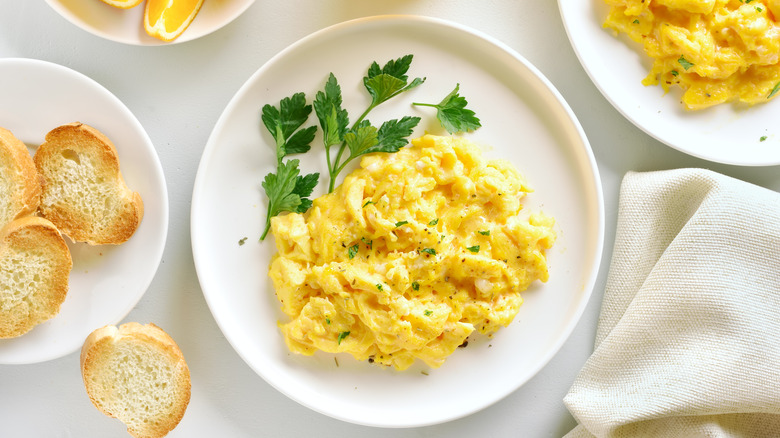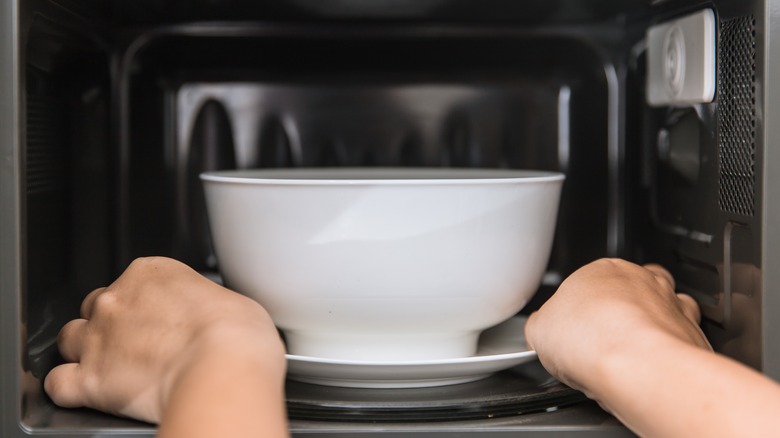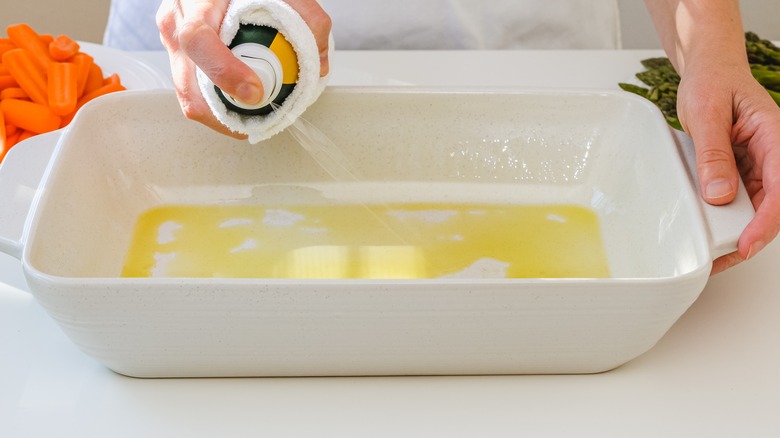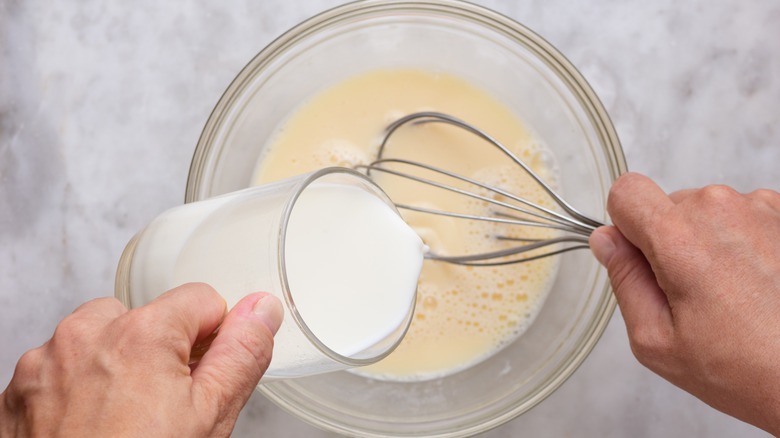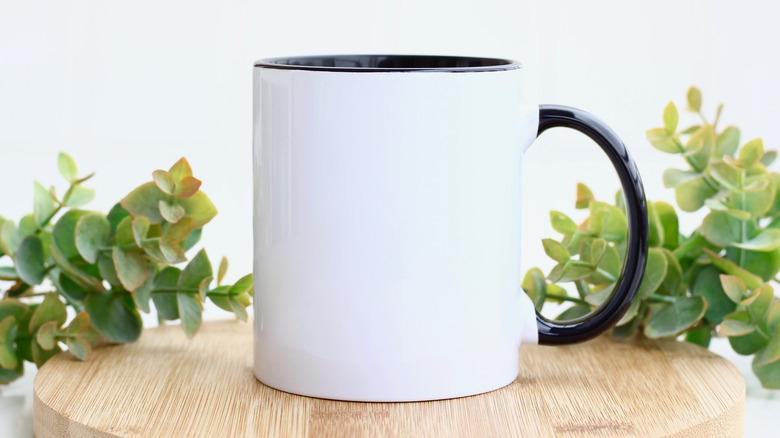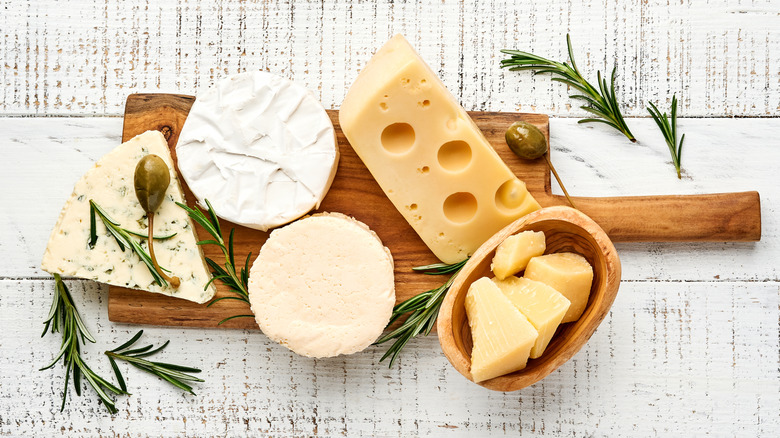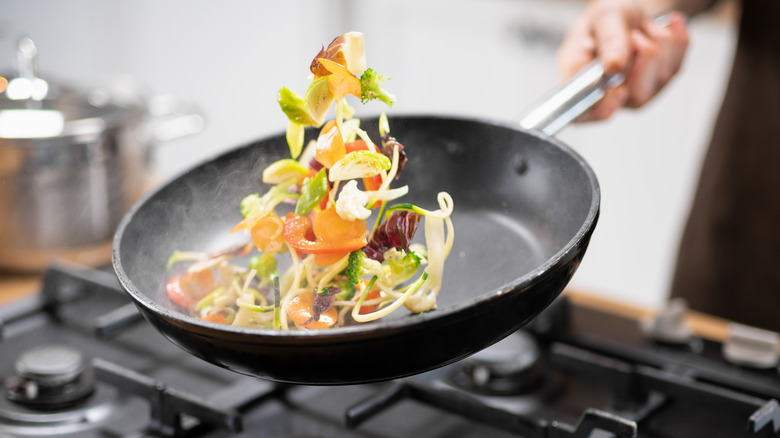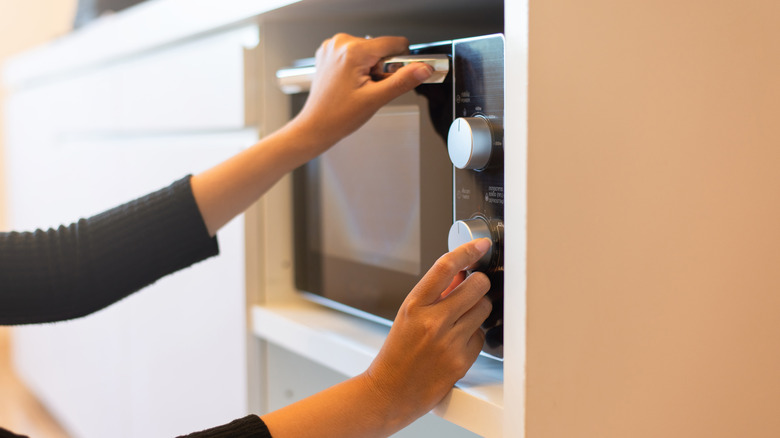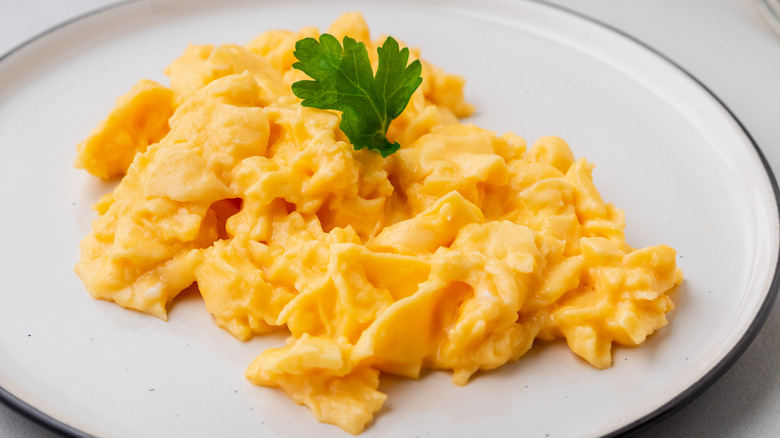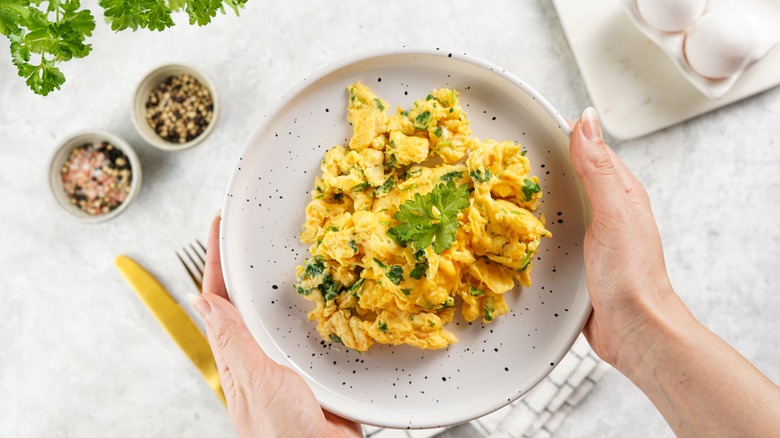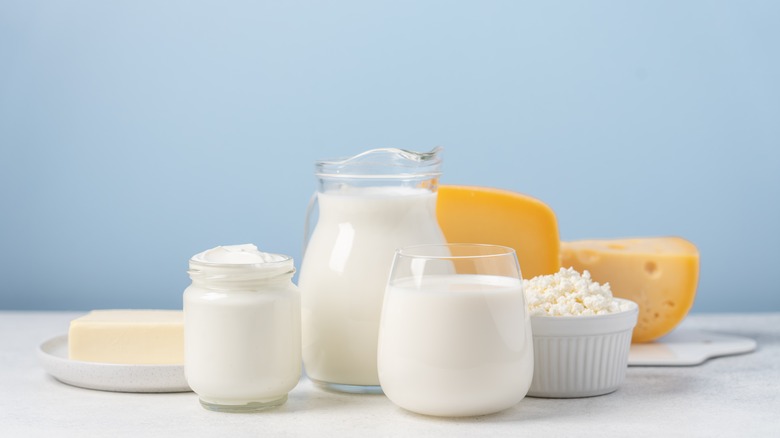Tips For Making Microwave Scrambled Eggs That Actually Taste Good
Making scrambled eggs in the microwave is a quick option when you have only a few minutes to put breakfast together. Unfortunately, however, they are temperamental and surprisingly difficult to get right. One second they're liquid, and the next, they're like rubber. Sometimes they look perfect when you remove them from the microwave, only to deflate moments later. They can be soggy, spongy, and flat, but achieving that fluffy, creamy texture you're after is so rare that it's almost mythical. But don't give up hope. We're here to tell you exactly how to make those microwave scrambled eggs light and airy, just like they should be. With a few adjustments, you'll be turning to the microwave to make your eggs even when you're not pressed for time.
Using the microwave has many benefits. For one thing, it might be healthier than other types of cooking, despite the rampant myths about microwaves that you've probably read. Frying, baking, and boiling food has been shown to destroy as much as 80% to 90% of nutrients due to the lengths at which the food is exposed to heat. Microwaves, on the other hand, heat food much faster, leaving more nutrients unscathed. Beyond the health benefits, using your microwave to cook eggs is fast and won't leave you with a pile of dishes in your sink. Follow these tips, and you'll wonder why it took you so long to transition from stovetop to microwave scrambled eggs.
Choose a dish without corners
Making an evenly cooked scramble starts with the shape of your container. You've probably noticed that when you put dense food in the microwave, such as mashed potatoes or oatmeal, the outside heats up while the inside stays cool. This is because microwaves warm food in an entirely different way than a stove or an oven. Instead of using heat, they produce electromagnetic waves that zap your food with radiation. This causes the water molecules in the food to vibrate, which generates heat.
When you microwave food in a square or rectangular dish, the corners are hit with a disproportionate concentration of electromagnetic waves because they are receiving them from four angles (top, bottom, and two sides). This makes the corners of the food cook more quickly and creates an uneven result. A round dish, in contrast, allows for more evenly distributed heat since each section is receiving radiation from the side, top, and bottom. The middle will still cook more slowly because it relies on the food around it to conduct heat, but you won't have overcooked corners.
If you want to ensure the most evenly cooked microwave eggs possible, use a ring-shaped dish. With no corners or a center, the contents are all heated at the same rate. Luckily, you don't need a ring-shaped dish to make delicious microwave eggs, but if you have one lying around, it's worth a try.
Grease the container you're using
You can follow all the instructions for microwaved eggs and create a light, fluffy scramble that fulfills all your breakfast dreams, only to find that, when you're finally ready to spoon it onto a plate, it's stuck like glue to your bowl. This unfortunate yet common situation is the result of protein strands in the eggs that bind to each other and to the cooking dish when heated. Not only does this make it difficult to extract the eggs from the container, but it also causes a headache when the time comes to do the dishes. You may as well be scrubbing hardened cement.
The good news is that you can solve the problem with a little grease. Simply spritz some non-stick cooking spray over your dish before pouring in the whisked eggs. Microwave cooking requires less effort than stovetop cooking in many ways, but greasing the dish that's about to be zapped by electromagnetic waves is just as important as greasing that pan that's about to be heated over an open flame. You'll thank yourself later.
If you want to hit two birds with one stone, swap cooking spray for butter or ghee to add more flavor to your scramble. Both will suffuse the eggs with a rich, nutty taste that is absent from vegetable oil and keep them from sticking to the dish.
Make sure to whisk in some milk or water
Microwaved eggs can become flat and rubbery very quickly. Because they're heated from all angles instead of from just the bottom like they are when you cook them on the stovetop, they can heat up too rapidly and lose all their moisture. To combat this problem, adding liquid to your eggs is essential.
Just one teaspoon of liquid per egg will help keep the scramble fluffy by turning to steam and pushing apart the strands of protein in the egg before they can bind and turn into a rubbery pancake. Most recipes call for water or milk in your scrambled eggs, but which one you choose is a matter of personal preference. Opt for milk if you prefer a creamier, denser consistency, or choose water if you want your eggs to be fluffy and light as air. You can even use cream, broth, or a plant-based milk.
To maximize the puffiness of your scramble, make sure to whisk the eggs and whatever liquid you choose vigorously before putting the mixture in the microwave. The more air you can whip into the eggs at this stage, the lighter your final product will be.
If you're making one serving, use a mug instead of a bowl
One of the ways to avoid cooking your eggs too quickly is to ensure you're using the right size dish. If the mixture is too shallow, it will heat rapidly and turn to rubber in the time it takes to have a sip of coffee. If it's too deep, it will take a while for the eggs to cook, and you'll be wondering why you bothered with the microwave instead of using the stovetop. When choosing your dish, make sure the uncooked eggs are at least half an inch deep. If you're cooking one or two eggs, a standard coffee mug is the perfect size. It's also a handy way to personalize your scrambled eggs if you're cooking for multiple people. Instead of using one large bowl, divide the whisked eggs between several mugs and let each person add their favorite seasonings.
If you're cooking more than one or two eggs at a time, opt for a container with a capacity of one cup per egg, as long as the eggs are a half-inch deep. For example, if you're cooking four eggs, you'll want to use a one-quart bowl. Eggs expand as they cook, and a container with plenty of room will prevent them from overflowing and forcing you to spend the morning cleaning your microwave.
Customize the taste with additional ingredients
Egg purists might like to keep things simple, but there are many ingredients you can use to take your scrambled eggs to the next level. Salt is a necessity with eggs, but you might also choose to add pepper, a dash of garlic powder, dried herbs, or even a hint of paprika or cayenne pepper. Cheese is another option that is sure to get your mouth watering, but whether you prefer Parmesan, cream cheese, or camembert, it's best to add it toward the end of the cooking process so that it melts into the eggs but doesn't get rubbery or prevent them from fluffing up.
You can also add liquid ingredients in addition to water or milk. Soy sauce and salsa are popular options, while some people opt for more unusual flavorings such as orange juice or vinegar. Just make sure that when you add liquid flavorings, you cut back on the milk or water. Adding too much liquid will make your eggs simultaneously soggy and overcooked because you'll likely leave them in the microwave longer trying to make the excessive liquid evaporate as steam.
Cook vegetables before adding them to your eggs
If you like scrambled eggs with vegetables, it's best to cook them separately. Otherwise, the veggies will release liquid into your eggs as they cook, creating an unappetizing puddle. Vegetables also cook at different rates. Fresh spinach wilts quickly, for example, while peppers and onions will still be nearly raw when your eggs are finished. Tomatoes fall somewhere in the middle of the spectrum. Cooking the veggies separately will add extra time to the process and leave you with extra dirty dishes, but if you're in a hurry, you can always just go hunting through your fridge for leftovers instead of dicing and sautéing fresh vegetables.
Even if you do cook the veggies first, you might want to wait to add them to your eggs until partway through cooking. If you mix them in while the eggs are still raw, they can weigh down the mixture, preventing the curds from puffing up. The veggies can also end up rubbery since you'll be cooking them for a second time. Adding them to the eggs halfway through the cooking process is the happy medium. The veggies will be hot but not overcooked, and there will be no greenish-brown puddles in sight.
Cook the eggs in 30-second intervals and stir
Scrambled eggs take only a few minutes to cook in the microwave, but the process requires more legwork than you might think. To make sure they're light and fluffy, you need to stand at the microwave and check on them at least every 30 seconds. Remove them from the microwave and stir, moving the outside edges to the inside for an even scramble.
If you let the eggs cook unattended for two or three minutes, you'll end up with rubbery, overcooked edges and an undercooked center. As with stovetop scrambled eggs, the intervals at which you stir them is a delicate balance. If you don't stir them enough, you'll end up with overcooked sections mixed with undercooked sections. But if you stir them too much, you'll knock all the air out of them and prevent them from puffing up or congealing, making them flat and rubbery rather than pillowy and custardy. Instead of whisking or stirring the eggs during the cooking process, think of it as scooping and turning the mixture. That way, you'll get the balance just right.
Choose a power setting
Power settings on microwaves are significantly more complicated than heat settings on a stove, and the confusion is made worse by the wild variations between appliance models. Besides the obvious differences between low, medium, and high power, many microwaves have settings for specific foods, such as popcorn, soup, and frozen vegetables. Newer models even have settings for the type of heating you want, such as steaming, melting, defrosting, and crisping.
When it comes to scrambled eggs, it's best to stick to simple settings to yield predictable results. Since microwaves cook quickly, you should avoid using the high setting unless you're prepared to stir the eggs every 10 seconds. Low power makes it easier to avoid overcooking your scramble and extends the intervals that you have to check them, but it also takes longer. Splitting the difference and using the medium power setting is likely to yield the best results. The outcome depends somewhat on your microwave and how you like your eggs. But once you've made scrambled eggs in the microwave a few times, you'll know which power setting works best for you.
Make sure to undercook them slightly
You might think that you should leave the eggs in the microwave until they've reached your preferred consistency, but this isn't the case. Those water molecules will continue to vibrate for about a minute after you've removed the bowl from the machine, passing heat through your eggs and continuing to cook them. If you leave them in the microwave until they're done, you'll end up eating an overcooked scramble, convinced the recipe led you astray. The instructions may not have explicitly stated this step, but removing the eggs from their heat source before they're finished is one of the keys to getting perfectly moist results.
Gordon Ramsay takes the cooling process a step further by adding creme fraiche immediately after removing his eggs from the heat. This neutralizes the temperature and prevents the scramble from continuing to cook. Whether you choose to let your eggs cool naturally or try Ramsay's trick, finding a middle ground between overcooking and undercooking can be challenging. When in doubt, opt for removing the eggs from the microwave too early rather than too late. You can always put them back in for another 10 to 15 seconds.
Add some toppings for extra flavor
Scrambled eggs are one of the most versatile breakfasts because they pair well with all kinds of ingredients. Like rice, you can put them with just about any savory food, and they'll taste like a match made in heaven. Once you've produced a bowl of piping-hot clouds of eggs, get creative. Whether you plan to pile them on sourdough toast or shovel them inside a tortilla, adding toppings will elevate your breakfast to restaurant status.
Smoked salmon is a natural fit, giving you a nutritional boost of omega-3 fatty acids and packing a delicious punch with its smoky, salty flavor. Avocado is just as healthy and filling, and while it might be a millennial cliché, the reason people are obsessed with avocado toast is that it offers the elusive combination of being both healthy and decadent. And speaking of decadence, there is no reason why you can't double or triple your cheese. Sprinkle your eggs with Parmesan or feta no matter how much cheddar or gruyère you added halfway through cooking.
You might be in search of something lighter and fresher rather than toppings that are heavy in fat. If you're wanting to balance out the creaminess of the eggs, fresh herbs, such as parsley or oregano, will give you a zesty kick of flavor. Fresh tomatoes will offer sweetness and acidity to cut through the fat in the eggs. And arugula will satisfy your taste buds if you want something spicier.
Ingredient hacks to keep the eggs creamy and fluffy
Sometimes, despite your best efforts, microwaved scrambled eggs refuse to cooperate and come out of the machine looking more like a soggy sponge than a breakfast. You added liquid, whisked air into them, cooked them at medium heat, and stirred them frequently, yet they ended up flat and unappetizing. In this situation, you can start experimenting with ingredients that cooks (including at least one celebrity chef) swear by to keep their scrambles light and creamy.
Whole milk, cream, and cream cheese will increase the fat content and make your eggs extra creamy, but they won't make them fluffier. Cottage cheese, on the other hand, can bulk up the mixture and dilute the proteins, making your final product more custardy than curdy. It's a great alternative to cream if you're trying to keep your eggs healthy, given its comparatively low-fat content and high protein.
Chef José Andrés revealed in a TikTok video that his secret to a fluffy microwave scramble has nothing to do with dairy. For him, mayonnaise is the magic ingredient that will transform your eggs into heavenly, fluffy clouds. Simply add one heaping tablespoon of mayo per egg, and whisk them until they are light, creamy, and fully incorporated. He chooses to cook them only until they hold their shape when turned out of their bowl but are still liquid on the inside. The result is so creamy that it could act as a substitute for burrata cheese.
